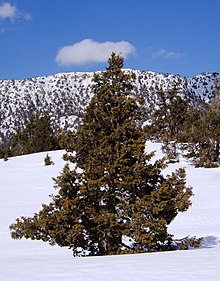Juniperus polycarpos: Difference between revisions
PhnomPencil (talk | contribs) m →Cultivation and uses: Fixing links to disambiguation pages -- Kalat, typos fixed: , → , using AWB |
Baloch Baba (talk | contribs) |
||
| Line 25: | Line 25: | ||
==Cultivation and uses== |
==Cultivation and uses== |
||
Junipers Juniperus macropoda are found in [[Ziarat]], [[Zarghoon Ghar]] Zarghoon Mount [[Quetta]], [[Kalat District|Kalat]] districts of [[Balochistan (Pakistan)|Balochistan]] on an approximate area of about {{convert|200000|acre|km2}}. The largest compact block lies in Ziarat district which covers an area of about {{convert|247000|acre|km2}} known as the second largest Juniper forest in the world. |
Junipers Juniperus macropoda are found in [[Ziarat]], [[Zarghoon Ghar]] Zarghoon Mount [[Quetta]], [[Harboi]] [[Kalat District|Kalat]] districts of [[Balochistan (Pakistan)|Balochistan]] on an approximate area of about {{convert|200000|acre|km2}}. The largest compact block lies in Ziarat district which covers an area of about {{convert|247000|acre|km2}} known as the second largest Juniper forest in the world. |
||
In October 29, 2008 a [[2008 Pakistan earthquake|6.4 magnitude Mw earthquake]] hit the Ziarat and surrounding areas after the earthquake distractions the local villagers are now using Juniper trees as fire wood this is very critical time for junipers to be protected. The juniper forest area is declining day by day there is lack of substantial remedial steps to minimize pressure on Juniper cutting has ever been taken to save the centuries old valuable trees. The local people living in these areas are not provided with the basic necessities of life. So |
In October 29, 2008 a [[2008 Pakistan earthquake|6.4 magnitude Mw earthquake]] hit the Ziarat and surrounding areas after the earthquake distractions the local villagers are now using Juniper trees as fire wood this is very critical time for junipers to be protected. The juniper forest area is declining day by day there is lack of substantial remedial steps to minimize pressure on Juniper cutting has ever been taken to save the centuries old valuable trees. The local people living in these areas are not provided with the basic necessities of life. So, they exploit the forest resources for fuel, shelter and food. The major reason of decline of this forest is uses as firewood for daily use, Timber for construction of hutment, hedges around agricultural fields by the local communities is resulting change in the environment and endangering the rare species of wildlife. Other threats to Juniper include the smuggling of juniper seeds and attack of plant parasite knows as “Mistletoe” or “Arceuthobium oxycedri” which destroys it in short period, |
||
There are many important species found, bushes and ground flora etc. are associated with this species. |
There are many important species found, bushes and ground flora etc. are associated with this species. Local people use ground flora and these plants as indigenous treatments for a variety of diseases. |
||
==References== |
==References== |
||
Revision as of 18:11, 24 August 2012
This article needs additional citations for verification. (December 2009) |
| Juniperus macropoda | |
|---|---|

| |
| Scientific classification | |
| Kingdom: | |
| Division: | |
| Class: | |
| Order: | |
| Family: | |
| Genus: | |
| Species: | J. macropoda
|
| Binomial name | |
| Juniperus macropoda | |
Juniperus macropoda (Juniperus excelsa polycarpus or Pashthani Juniper) is a unique ecosystem and is considered as the oldest living creatures on the surface of earth.
Classification
Juniperus macropoda also known as a "living fossil".[1] According some estimation its age ranges from 2000 to 2500 years.[citation needed][2] Its botanical name is Juniperus macropoda and family name is Cupressaceae local name Pashthani Juniper but in Urdu people called it Sanabor.

Cultivation and uses
Junipers Juniperus macropoda are found in Ziarat, Zarghoon Ghar Zarghoon Mount Quetta, Harboi Kalat districts of Balochistan on an approximate area of about 200,000 acres (810 km2). The largest compact block lies in Ziarat district which covers an area of about 247,000 acres (1,000 km2) known as the second largest Juniper forest in the world.
In October 29, 2008 a 6.4 magnitude Mw earthquake hit the Ziarat and surrounding areas after the earthquake distractions the local villagers are now using Juniper trees as fire wood this is very critical time for junipers to be protected. The juniper forest area is declining day by day there is lack of substantial remedial steps to minimize pressure on Juniper cutting has ever been taken to save the centuries old valuable trees. The local people living in these areas are not provided with the basic necessities of life. So, they exploit the forest resources for fuel, shelter and food. The major reason of decline of this forest is uses as firewood for daily use, Timber for construction of hutment, hedges around agricultural fields by the local communities is resulting change in the environment and endangering the rare species of wildlife. Other threats to Juniper include the smuggling of juniper seeds and attack of plant parasite knows as “Mistletoe” or “Arceuthobium oxycedri” which destroys it in short period,
There are many important species found, bushes and ground flora etc. are associated with this species. Local people use ground flora and these plants as indigenous treatments for a variety of diseases.

